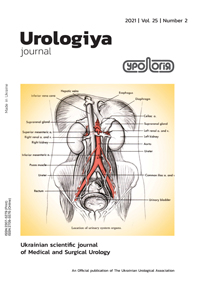Urinary tract microbiota as affected by urodynamic disorders and decompensation of type 2 diabetes mellitus
DOI:
https://doi.org/10.26641/2307-5279.25.3.2021.241648Keywords:
diabetes mellitus, urodynamics, microbiota, urineAbstract
The aim of the study was to study the features of the urinary microbiota in patients with urodynamic disorders of the lower urinary tract on the background of decompensated type 2 diabetes.
Material and methods. The study was performed on the basis of MCL №10 (Odessa) in 2019-2020. We examined 50 patients with decompensated diabetes mellitus2 with manifestations of urodynamics of the lower urinary tract (main group) and 30 healthy individuals of the same age, examined according to the medical program. The mean age of patients was 42.4 ± 1.1 years. The sample was dominated by women (38 (76.0%) of the main group, 19 (63.3%) of the control group). Among the disorders of urodynamics dominated by manifestations of incontinence. In all patients, fasting blood glucose, glycated hemoglobin HbA1c, glucosuria were determined, and PGS index was calculated.
Results. All patients in the main group showed signs of decompensation of diabetes. The average glycemic level was 11.3 ± 1.1 mmol / l, HbA1c content - 8.8 ± 0.9%. The value of PGS in the main group averaged 122 ± 9 units.
When assessing the qualitative composition of urine microbiocenoses, it was found that patients of the main group were often identified bacteria of intestinal origin. The total microbial count in the main group averaged 2x107 CFU/ml (cv = 5%), in the control group - 1x104 CFU/ml (cv = 10 %).
Conclusions. 1. In patients with diabetes mellitus 2 who have urodynamic disorders, there is both asymptomatic and symptomatic bacteriuria. 2. Urinary microbiota in patients with diabetes mellitus is represented by facultative aerobes and anaerobes. 3. There is a close correlation between the qualitative composition of the intestinal microbiota and the urinary tract in patients with decompensated diabetes mellitus2. 4. To reduce the risk of urinary tract infection in patients with diabetes mellitus, it is advisable to take measures to compensate for the course of the disease, avoid prolonged use of catheters and prophylactic use of uroseptics.
References
Liu J., Ren Z.H., Qiang H. et al. Trends in the incidence of diabetes mellitus: results from the Global Burden of Disease Study 2017 and implications for diabetes mellitus prevention. BMC Public Health. 2020. Vol. 20(1). P. 1415.
Balkau B., Holt R.I.G. Learning about diabetes through epidemiology. Diabet Med. 2019. Vol. 36(10). P. 1195–1198. Doi: 10.1111/dme.14120.
Ackerman A.L., Chai T.C. The Bladder is Not Sterile: an Update on the Urinary Microbiome. Curr Bladder Dysfunct Rep. 2019. Vol. 14(4). P. 331–341.
Gandhi J., Dagur G., Warren K., Smith N.L., Khan S.A. Genitourinary Complications of Diabetes Mellitus: An Overview of Pathogenesis, Evaluation, and Management. Curr Diabetes Rev. 2017. Vol. 13(5). P. 498–518.
Papaefstathiou E., Moysidis K., Sarafis P., Ioannidis E., Hatzimouratidis K. The impact of Diabetes Mellitus on Lower urinary tract symptoms (LUTS) in both male and female patients. Diabetes Metab Syndr. 2019. Vol. 13(1). P. 454–457.
Penckofer S., Limeira R., Joyce C., Grzesiak M., Thomas-White K., Wolfe A.J. Characteristics of the microbiota in the urine of women with type 2 diabetes. J Diabetes Complications. 2020. Vol. 34(6).
Гурженко Ю.Н. и др. Исследование эффективности использования препарата Диурол в комплексном лечении больных хроническим циститом. Семейная медицина. 2015. № 1. С . 70–74.
Возіанов С.О., Гурженко А.Ю. Аналіз післяопераційних ускладнень у хворих на цукровий діабет після проведення малоінвазивних втручань з приводу уретеролітіазу. Семейная медицина. 2017. № 3. С. 99–103.
Пасєчніков С.П. и др. Особливості складу госпіталізованих хворих на доброякісну гіперплазію передміхурової залози в аспекті амбулаторного етапу медичної допомоги. Здоровье мужчины. 2018. № 2. С. 59–64.
Drake M.J., Doumouchtsis S.K., Hashim H., Gammie A. Fundamentals of urodynamic practice, based on International Continence Society good urodynamic practices recommendations. Neurourol Urodyn. 2018. Vol. 37. P. 50–60. Doi: 10.1002/nau.23773.
Клінічна лабораторна діагностика / за ред. Л.Є. Лаповець. К.: Медицина, 2019. 471 с.
Rodrнguez-Gutiйrrez R., Montori V.M. Glycemic Control for Patients With Type 2 Diabetes Mellitus: Our Evolving Faith in the Face of Evidence. Circ Cardiovasc Qual Outcomes. 2016. Vol. 9(5). P. 504–512.
Коротяев А.И., Бабичев С.А. Медицинская микробиология, иммунология и вирусология. СПб.: СпецЛит, 2008. 415 с.
Халафян А.А. Математическая статистика с элементами теории вероятностей. М.: Бином, 2011. 496 с.
Downloads
Published
Issue
Section
License
Стаття повинна мати візу керівника та офіційне направлення від установи, з якої виходить стаття (з круглою печаткою), і вказівкою, чи є стаття дисертаційною, а також у довільній формі на окремому аркуші - відомості про авторів (прізвище, ім’я, по батькові, посада, вчений ступінь, місце роботи, адреса, контактні телефони, E-mail).
Стаття повина бути підписана всіма авторами, які укладають з редакцією договір пропередачу авторських прав (заповнюється на кожного автора окремо з оригінальним підписом). За таких умов редакція має право на її публікацію та розміщення на сайті видавництва.

